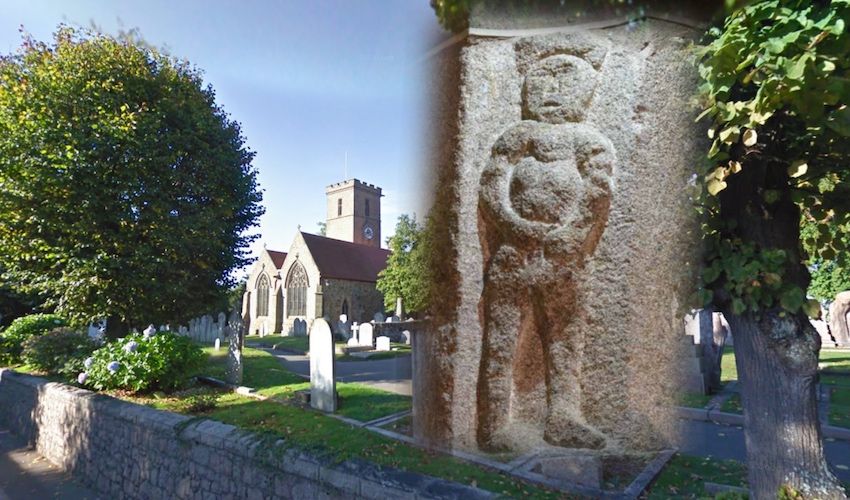


An archaeologist has uncovered what appears to be a rare and ancient fertility symbol dating back to the 11th century carved into the granite of a local church.
If the researcher’s assessment of the carving is correct, it could be one of just 60 others of its kind in England, and the only one to be discovered in the Channel Islands.
Freelance archaeologist Rosalind Le Quesne told Express she first saw the carving whilst working in the cemetery at St. Saviour’s Church in 2017. However, at the time it was described to her as a figure of Adam.
Video: An interactive 3D model of the St. Saviour Sheela. (SketchFab/Rosalind Le Quesne - Underground)
It was only upon stumbling across an article early last year about the ancient ‘Sheela-na-gig’ - a medieval representation of a female figure originating in 11th century Normandy believed to ward off evil and bring good luck - that Rosalind thought twice about the carving.
“I was stunned to see this figure shared some of the same physical characteristics and could also be a Sheela."
Having never heard of ‘Sheelas’ before, Rosalind then delved into some extensive research about the figures and what they represent.
She explained: “What makes them difficult to identify is that they are all so stylistically different and can be shown in various positions, so you really have to consider their context and placement too.
“So not only does she share the physical characteristics of other Sheelas, like holding her genitals with both hands, but she also appeared around the right time, in the right social setting, and where she is positioned within the church is consistent with the Sheela's function of warding off evil.”
Now she has published a paper on her discovery at the church and, although it’s not possible to have an official verification, the Jersey figure has been accepted by the 'Sheela-na-gig Project' – an online database aimed to find and document ‘Sheelas’ across the UK.

Pictured: Rosalind first came across the carving in 2017 when she was working in the church cemetery. (Rosalind Le Quesne/Underground)
“Archaeology is all about making interpretations from the available evidence and of course there will be some disagreement with this interpretation, but the most important thing is that the discussion is opened up for people to participate in.”
In her paper, she writes about the significance of such a find and establishes just how rare surviving carvings of this nature are.
She says that if the ‘St. Saviour Sheela’ is indeed such a carving, it “would be the only recorded example of a Sheela- na-gig in the Channel Islands and would join a list of approximately 60 in England, 160 in Ireland, many in the Normandy and Charente areas of France, and a handful in Scotland, Wales, Denmark, Germany and Spain".
She explains that, due to their crude depictions of the female body and genitalia, many such Sheelas “were hacked away from their original settings by 16th century reformists or outraged post-medieval clergymen and their churchgoers”, which is why so few survive.
The freelance osteologist and researcher explains that although the meaning of these carvings is not fully understood, “their presence has been variously interpreted as bringing good luck, offering protection, warding off the evil eye, as symbols of fertility or pagan goddesses, or as warnings against lust."
Questioning how, if the carving is a Sheela, it would have survived the Reformation period in the island when “all idols and accoutrements of Catholic worship were removed from the churches; altars, stained glass and pictures were removed or whitewashed and heavy stone items were destroyed and buried”, Rosalind made another discovery.
She found that an internal wall in St. Saviour’s Church built before the Reformation shielded the Sheela from view and therefore protected it from vandalism.
“For the centuries during which the internal wall stood, it physically covered and protected the St. Saviour Sheela, before she was revealed once more when the wall was demolished in Adolphus Curry’s 1903 restoration," she writes.
Reflecting on the significance of this in her essay's concluding remarks, Rosalind adds: “Her rough-carved styling is that of the folk tradition rather than the Christian one, and she has survived the periods of turmoil that destroyed so many other Sheelas because she was hidden behind a wall. In more recent centuries she has remained hidden behind a different wall, that of the absence of a female researcher’s perspective, which has resulted in the failure to identify the powerful female symbolism that was once so deeply entrenched in Medieval culture.”
Pictured top: St. Saviour's Church (Google Maps), and the possible Sheela-na-gig. (Rosalind Le Quesne/Underground)
Comments
Comments on this story express the views of the commentator only, not Bailiwick Publishing. We are unable to guarantee the accuracy of any of those comments.